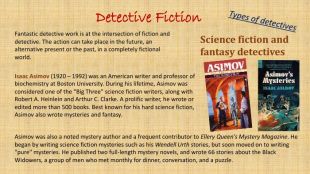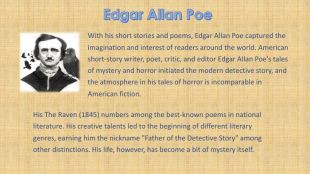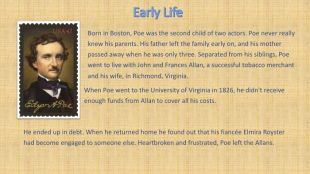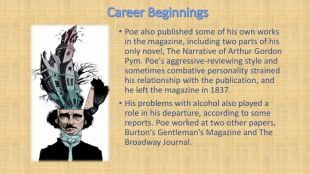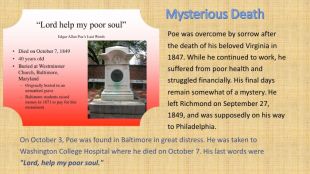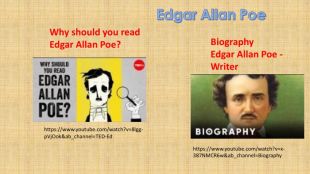Детективний жанр. Едгар Аллан По (презентація)

























Detective Fiction. Detective fiction is a subgenre of crime fiction and mystery fiction in which an investigator or a detective—whether professional, amateur or retired—investigates a crime, often murder. The detective genre began around the same time as speculative fiction and other genre fiction in the mid-nineteenth century and has remained extremely popular, particularly in novels. EDGAR POE is one of the classics of world literature. His talent is multifaceted - it is prose, poetry, literary and critical articles, reviews, as well as works whose genre is difficult to define (the scientific-astronomical poem "Eureka"). E. Poe is considered the founder, "father" of the detective genre.
Detective Fictionand later "The Mystery of Marie Roger" (1843) and "The Stolen Letter" (1844), the common protagonist of which was melancholy private detective and intellectual Dupin. The "birthday" of the detective genre is considered to be April 20, 1841, when Edgar Poe's story "Murder in the Rue Morgue" was first printed, Two more Poe novels are sometimes considered examples of the detective genre: "The Golden Beetle" (1843) and "You Are the Man Who Made This" (1844).
Detective Fiction. As for the reader, he acted on a par with great sleuthing and had the opportunity to work on the puzzle on his own. Solving this or that mystery, the reader must think logically, consistently, connecting his intellect, hence the name - intellectual.romantic (properly sensational), classical (properly intellectual) and gothic (terrible, scary). In works of the classical type, namely intellectual detectives, all the events, as a rule, took place in the first part, and then the detective moved forward until he completely solved the riddles. Edgar Allan Poe became the founder of three main directions in the detective story –
Detective Fictionlack of movements and emotions;the interest of the senses is focused on secrets, not on the tragedies of people;the crime had to be solved with the help of logical deductions, and not by chance or an unmotivated confession;monotony of the story, long stories of the heroes about various trifles;little attention is paid to large geographical boundaries. Features of the plot is built around a crime;in the center - the intellectual process of searching for the truth;the action took place in a very limited space;the main character is the only one who could succeed, who was as if programmed;victim - "object of investigation work";the detective was interested in the smallest details;the reader had the opportunity to follow the development of the investigator's opinion;the intellectual detective:
Detective Fiction The investigation is conducted by someone who is at the scene of the crime, with the help of other characters. This type of detective story is distinguished by the fact that the plot basically excludes the need to search for an unknown criminal. The suspects are obvious, and the investigator's job is to get as much information about the participants of the event as possible, on the basis of which it will be possible to identify the criminal. Types of detectives Closed view detective Agatha Christie "Ten Negroes",The plot is based on the investigation of a crime, which was committed in a secluded place, where a strictly limited circle of characters is located. No outsider should be in this place, so that the crime can be committed only by someone present. Additional psychological tension is created by the fact that the criminal must turn out to be one of the well-known people, from those who are nearby and usually do not look like the criminal. Sometimes in a closed-door detective, a whole series of crimes (usually murders) takes place, as a result of which the number of suspects is constantly decreasing.
Detective Fiction. Usually, the crime under investigation is committed for personal motives (envy, revenge), and the main element of the investigation is the study of the personal characteristics of the suspects, their habits, weaknesses, beliefs, superstitions, and finding out the past. There is even a school of French psychological detectives. Types of detectives Psychological detective This type of detective may deviate somewhat from the classical canons in terms of requirements for stereotypical behavior and typical psychology of heroes. James Brendan Patterson,an American author.
Detective Fiction. The historical mystery or historical whodunit is a subgenre of two literary genres, historical fiction and mystery fiction. These works are set in a time period considered historical from the author's perspective, and the central plot involves the solving of a mystery or crime (usually murder). The increasing popularity and prevalence of this type of fiction in subsequent decades has spawned a distinct subgenre recognized by the publishing industry and libraries. Publishers Weekly noted in 2010 of the genre, "The past decade has seen an explosion in both quantity and quality. Never before have so many historical mysteries been published, by so many gifted writers, and covering such a wide range of times and places."Types of detectives Historical mystery. Barbara Louise Mertz (pseudonyms Elizabeth Peters),an American author. She is best known for her mystery and suspense novels, in the 1960s she authored two books on ancient Egypt, both of which have remained in print ever since.
Detective Fiction. Fantastic detective work is at the intersection of fiction and detective. The action can take place in the future, an alternative present or the past, in a completely fictional world. Types of detectives Science fiction and fantasy detectives. Isaac Asimov (1920 – 1992) was an American writer and professor of biochemistry at Boston University. During his lifetime, Asimov was considered one of the "Big Three" science fiction writers, along with Robert A. Heinlein and Arthur C. Clarke. A prolific writer, he wrote or edited more than 500 books. Best known for his hard science fiction, Asimov also wrote mysteries and fantasy. Asimov was also a noted mystery author and a frequent contributor to Ellery Queen's Mystery Magazine. He began by writing science fiction mysteries such as his Wendell Urth stories, but soon moved on to writing "pure" mysteries. He published two full-length mystery novels, and wrote 66 stories about the Black Widowers, a group of men who met monthly for dinner, conversation, and a puzzle.
Detective Fiction. The main plot revolves around political events and competition between different political or business structures. It often happens that the protagonist himself is far from politics, but while investigating the case, he encounters obstacles in solving the crime from the authorities or some kind of rebellion is revealed. A distinctive feature of a political detective is (although not necessarily) the possible complete absence of positive heroes, except for the main one. This genre is rarely found in its pure form, but can be an integral part of a work. Types of detectives Political detective Jeffery Deaver is an American writer, journalist, lawyer. The author of books in the genres of thriller, mystery and criminal detective. One of the genres quite far from the classic detective story.
Detective Fiction. Types of detectives The main difference between a spy detective and a political one is that in a political detective the political basis of the case is more important, and antagonistic conflicts are also investigated, while in a spy detective the focus is on the investigation (espionage, sabotage, etc.). A conspiratorial detective can be considered a type of both espionage and political detectives. Spy detective Spy detective is based on stories about the activities of scouts, spies and saboteurs, both in wartime and in peacetime. In stylistic terms, it is very close to political and conspiratorial detectives, often combined in the same work. Robert Ludlum (1927 –2001) was an American author of 27 thriller novels, best known as the creator of Jason Bourne from the original The Bourne Trilogy series. The number of copies of his books in print is estimated between 300 million and 500 million. They have been published in 33 languages and 40 countries.
Detective Fiction. Types of detectives Gangster detective is the name of one of the most read types of detectives - more often this genre is called "cool" or "black" detective. Changes in real life, the expansion and strengthening of professional crime, the wave of gangsterism caused such a phenomenon as the appearance in the vast sea of adventure literature of a gangster detective who took a worthy place among his peers. Cool detective In the 1920s and 1930s, a new stage in the development of detectives began in the USA, a new school appeared - the "cool" or gangster detective. Its founder was the famous American writer Dashiell Hammett (1894-1961). During five years (from 1929 to 1934), he wrote five novels, several novels and short stories, which reflected the realities of life: new phenomena in the criminal world and in the activities of US law enforcement agencies. The novelty was the scale of crime in society. It became organized, more massive and aggressive, penetrating all spheres of business and state power, politics and economy. Hammett’s most famous novel is The Maltese Falcon.
Detective Fiction. Types of detectives A specific detective genre, since the criminal is known and the events are described from his point of view, and not from the people who are looking for him. Criminal detective James Myers Thompson (1906 –1977) was an American prose writer and screenwriter, known for his hardboiled crime fiction. Thompson wrote more than thirty novels, the majority of which were original paperback publications, published from the late-1940s through mid-1950s. A number of Thompson's books were adapted as popular films. Thompson's stories are about grifters, losers, sociopaths and psychopaths—some at the fringe of society, some at its heart—their nihilistic world-view being best-served by first-person narratives revealing a frighteningly deep understanding of the warped mind. There are few good guys in Thompson's literature: most of his characters are abusive or simply biding time until an opportunity presents itself, though many also have decent impulses.
Detective Fiction. Detective works do not leave adults or children indifferent. Love and hate, war and peace, man and society, good and evil - this is an incomplete list of those problems that concern writers of all times and nations. And the problem of crime and punishment is always relevant. The detective genre is very popular among readers of all ages.for kids
Edgar Allan Poe. With his short stories and poems, Edgar Allan Poe captured the imagination and interest of readers around the world. American short-story writer, poet, critic, and editor Edgar Allan Poe's tales of mystery and horror initiated the modern detective story, and the atmosphere in his tales of horror is incomparable in American fiction. His The Raven (1845) numbers among the best-known poems in national literature. His creative talents led to the beginning of different literary genres, earning him the nickname "Father of the Detective Story" among other distinctions. His life, however, has become a bit of mystery itself.
Early Life. He ended up in debt. When he returned home he found out that his fiancée Elmira Royster had become engaged to someone else. Heartbroken and frustrated, Poe left the Allans. When Poe went to the University of Virginia in 1826, he didn't receive enough funds from Allan to cover all his costs. Born in Boston, Poe was the second child of two actors. Poe never really knew his parents. His father left the family early on, and his mother passed away when he was only three. Separated from his siblings, Poe went to live with John and Frances Allan, a successful tobacco merchant and his wife, in Richmond, Virginia.
Career Beginnings. Poe published his first book, Tamerlane and Other Poems in 1827, and he had joined the army around this time. Poe wanted to go to West Point, a military academy, and won a spot there in 1830. Before going to West Point, he published a second collection Al Aaraaf, Tamberlane, and Minor Poems in 1829. Poe excelled at his studies at West Point, but he was kicked out after a year for his poor handling of his duties.
Career Beginnings. He moved around in search of opportunity, living in New York City, Baltimore, Philadelphia and Richmond. From 1831 to 1835, he stayed in Baltimore with his aunt Maria Clemm and her daughter Virginia. The couple married in 1836 when she was only 13 (or 14 as some sources say) years old. Returning to Richmond in 1835, Poe went to work for a magazine called the Southern Literary Messenger. There he developed a reputation as a cut-throat critic.
Career Beginnings. Poe also published some of his own works in the magazine, including two parts of his only novel, The Narrative of Arthur Gordon Pym. Poe's aggressive-reviewing style and sometimes combative personality strained his relationship with the publication, and he left the magazine in 1837. His problems with alcohol also played a role in his departure, according to some reports. Poe worked at two other papers, Burton's Gentleman's Magazine and The Broadway Journal.
Major Works. Poe launched the new genre of detective fiction with 1841's "The Murders in the Rue Morgue." A writer on the rise, he won a literary prize in 1843 for "The Gold Bug" . Poe became a literary sensation in 1845 with the publication of the poem "The Raven.“Beyond horror, Poe also wrote satires, humor tales.
Mysterious Death. Poe was overcome by sorrow after the death of his beloved Virginia in 1847. While he continued to work, he suffered from poor health and struggled financially. His final days remain somewhat of a mystery. He left Richmond on September 27, 1849, and was supposedly on his way to Philadelphia. On October 3, Poe was found in Baltimore in great distress. He was taken to Washington College Hospital where he died on October 7. His last words were "Lord, help my poor soul."
«I became insane, with long intervals of horrible sanity».«If you wish to forget anything on the spot, make a note that this thing is to be remembered».«There are chords in the hearts of the most reckless which cannot be touched without emotion».«I wish I could write as mysterious as a cat».«We loved with a love that was more than love».«With me poetry has not been a purpose, but a passion». Quotes
Questions for discussion. What date is considered to be the "birthday" of the detective genre?What are the main directions in the detective story?What are the main features of the intellectual detective?What are the types of detective stories and how they differ from one another?Are there any detective stories written specially for children?When did Poe publish his first book?In what types of literature did Poe work?


про публікацію авторської розробки
Додати розробку









